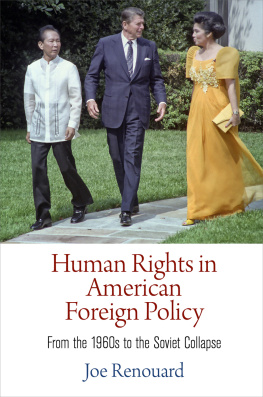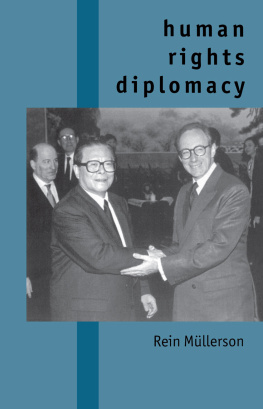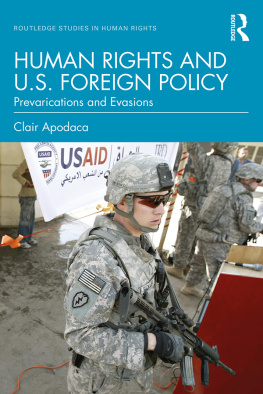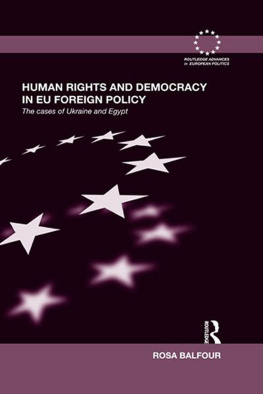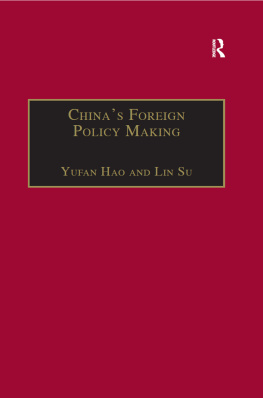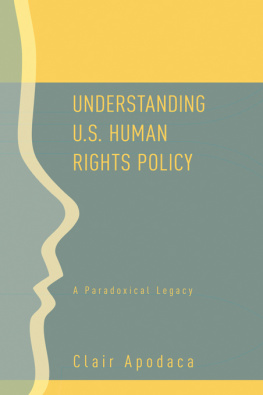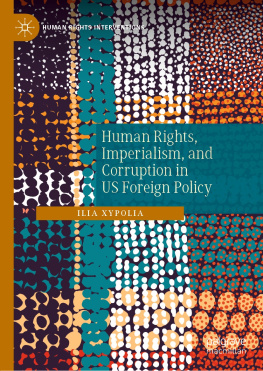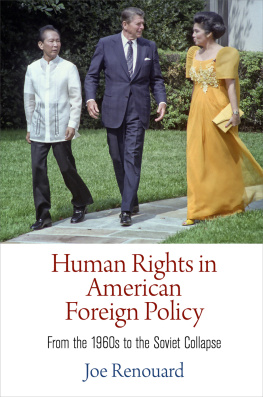Renouard Joe - Human Rights in American Foreign Policy
Here you can read online Renouard Joe - Human Rights in American Foreign Policy full text of the book (entire story) in english for free. Download pdf and epub, get meaning, cover and reviews about this ebook. year: 2015, publisher: University of Pennsylvania Press, genre: Politics. Description of the work, (preface) as well as reviews are available. Best literature library LitArk.com created for fans of good reading and offers a wide selection of genres:
Romance novel
Science fiction
Adventure
Detective
Science
History
Home and family
Prose
Art
Politics
Computer
Non-fiction
Religion
Business
Children
Humor
Choose a favorite category and find really read worthwhile books. Enjoy immersion in the world of imagination, feel the emotions of the characters or learn something new for yourself, make an fascinating discovery.
- Book:Human Rights in American Foreign Policy
- Author:
- Publisher:University of Pennsylvania Press
- Genre:
- Year:2015
- Rating:5 / 5
- Favourites:Add to favourites
- Your mark:
- 100
- 1
- 2
- 3
- 4
- 5
Human Rights in American Foreign Policy: summary, description and annotation
We offer to read an annotation, description, summary or preface (depends on what the author of the book "Human Rights in American Foreign Policy" wrote himself). If you haven't found the necessary information about the book — write in the comments, we will try to find it.
Human Rights in American Foreign Policy — read online for free the complete book (whole text) full work
Below is the text of the book, divided by pages. System saving the place of the last page read, allows you to conveniently read the book "Human Rights in American Foreign Policy" online for free, without having to search again every time where you left off. Put a bookmark, and you can go to the page where you finished reading at any time.
Font size:
Interval:
Bookmark:

Human Rights in American Foreign Policy
PENNSYLVANIA STUDIES IN HUMAN RIGHTS
Bert B. Lockwood, Jr., Series Editor
A complete list of books in the series is available from the publisher.
Human Rights in American Foreign Policy
From the 1960s to the Soviet Collapse
Joe Renouard
PENN
UNIVERSITY OF PENNSYLVANIA PRESS
PHILADELPHIA
Copyright 2016 University of Pennsylvania Press
All rights reserved. Except for brief quotations used for purposes of review or scholarly citation, none of this book may be reproduced in any form by any means without written permission from the publisher.
Published by
University of Pennsylvania Press
Philadelphia, Pennsylvania 19104-4112
www.upenn.edu/pennpress
Printed in the United States of America
on acid-free paper
10 9 8 7 6 5 4 3 2 1
Library of Congress Cataloging-in-Publication Data
Renouard, Joe, author.
Human rights in American foreign policy : from the 1960s to the Soviet collapse / Joe Renouard.
pages cm. (Pennsylvania studies in human rights)
ISBN 978-0-8122-4773-2 (alk. paper)
1. United StatesForeign relations19451989. 2. United StatesForeign relations19891993. 3. DiplomacyMoral and ethical aspects20th century. 4. Human rightsGovernment policyUnited States20th century. 5. Cold War. I. Title. II. Series: Pennsylvania studies in human rights.
JZ1480.R465 2016
327.11dc23
2015022968
For my family
What has for centuries raised man above the beast is not the cudgel but an inward music: the irresistible power of unarmed truth.
Boris Pasternak
Contents
Introduction: A Riot in Washington
November 15, 1977, began like most any other fall day in Washington. The morning temperature hovered in the upper forties, and the forecast called for an afternoon high of around sixty. It had been unusually cool in the District of late, and residents welcomed the return of warmer weather. On Capitol Hill, the 95th Congress was working through its customary autumn slate of committee hearings and legislative proposals, with staffers poring over reams of bills on foreign affairs, the economy, and the more mundane matters of congressional governance. At the White House, President Jimmy Carters morning was taken up with the usual round of cabinet meetings and advisers briefings, as well as an interview with New York Times foreign affairs columnist C. L. Sulzberger.
The central item on Carters agenda that day was an official visit by the head of state of Iran, Shah Reza Pahlavi. The United States had maintained a special relationship with the Shah for a quarter of a century, and the new American president was eagerly anticipating his first meeting with this longtime ally. In accordance with the Shahs importance to the United States, the White House planned to pull out all the stops with a state dinner, policy meetings, and multiple photo ops with the Shah and his elegant wife, Empress Farah. The United States had many reasons to value the Shahs friendship. Not only did he provide a steady source of oil, but he had solidified relations with Israel and the large Arab states of Egypt and Saudi Arabia, and he stood as a reliable bulwark against Soviet ambitions along the two nations fifteen-hundred-mile border. In return for the Shahs secular anticommunism, oil, and Western orientation, the United States had provided him with modern weapons, diplomatic support, and favorable trade deals.
There was just one problem: the Western-leaning, Western-educated Shah was no Western liberal. He had ascended the throne in 1941, and he But his one-party government was neither liberal nor democratic.
The Shahs human rights record had been of little interest to American policymakers, but Jimmy Carter was a new kind of executive. He had campaigned on a promise to bring moral values to governance, and since his inauguration he had pursued an ambitious human rights policy. This activism put him into a difficult position. If he publicly confronted the Shah, he would damage the vital U.S.-Iran relationship. But if he ignored the Shahs transgressions, he would risk losing credibility for all of his policies, including human rights. With U.S.-Iran ties and his own policies in flux, Carter hoped to steer a middle course by publicly supporting the Shah, continuing the special relationship, and addressing Iranian human rights in private.
In keeping with the tradition of state visits to the White House, the schedule called for a welcoming reception on the South Lawn. Such ceremonies were common, but this time thousands of pro- and anti-Shah demonstrators were expected, and the presence of two opposing groups created the potential for violence. By ten oclock that morning, around eight thousand had arrived. The anti-Shah crowd was an unusual mix of students, Marxists, Muslims, and liberals who were united only in their loathing of the Shah. Well-known figures from the 1960s antiwar movement proclaimed Iran to be Americas worst police-state ally, while an Iranian student group declared that the U.S. government, multinational corporate interests, and the Shah were engaged in an orchestrated effort to mask the reality of oppression in Iran. The pro-Shah group, meanwhile, was composed of expatriate Iranian students, professionals, and diplomats. Rumors abounded as to who was funding the demonstrations, with each side predictably accusing the other of dubious backing and malevolent motives.
Tensions were high on the Ellipse just south of the White House, where upward of three thousand people were split into pro- and anti-Shah camps with a line of mounted police between them. Many in the anti-Shah group wore masks to avoid (so they said) being photographed and identified by the Shahs secret police. As each side eyed the other nervously and exchanged insults, the match that lit the dynamite was the arrival of the Shah. When he was ushered out to the South Lawn and his twenty-one-gun salute rang out over the Ellipse, all hell broke loose. The anti-Shah demonstrators attacked the Shahs supporters with rocks, bottles, fists, and wooden planks that were piled up for construction of the upcoming Christmas Pageant of Peace. The younger members of the pro-Shah contingent fought back. Outnumbered and in danger, the police fired tear gas to disperse the crowd.
A few hundred yards away on the South Lawn, the ceremonys well-dressed attendees quickly realized that something was amiss. Carter later recalled hearing in the distance the faint but unmistakable sounds of a mob before the gathering was enshrouded in tear gas. The entourage then retired to the White House. Back on the Ellipse, the police succeeded in separating the two groups and shepherding them out of the area. All told, there were 124 injuries. The police took extra precautions throughout the remainder of the Shahs visit, including placing riot police inside the White House fences and sharpshooters on the roof.
Unfortunately for Carter and the Shah, the world news media paid little attention to their words on the South Lawn, instead focusing on the riotthe bloodiest in Washington since the Vietnam Warand its effect on the august ceremony. Newspapers around the world published front-page photos of the dignitaries wiping away tears as Carter spoke at the podium. The footage shocked Iranians, who had never seen their leader in such apparent peril. Many took the riot as evidence that American support for the Shah was on the wane; why else, they asked, would the Americans have allowed these protests to take place? We learned last night, said one Iranian in Washington, that news of our protest efforts had reached home, and the people were rejoicing. When they saw the Shah wipe his eyes from the tear gas, they thought we had gassed [him]!
Next pageFont size:
Interval:
Bookmark:
Similar books «Human Rights in American Foreign Policy»
Look at similar books to Human Rights in American Foreign Policy. We have selected literature similar in name and meaning in the hope of providing readers with more options to find new, interesting, not yet read works.
Discussion, reviews of the book Human Rights in American Foreign Policy and just readers' own opinions. Leave your comments, write what you think about the work, its meaning or the main characters. Specify what exactly you liked and what you didn't like, and why you think so.

